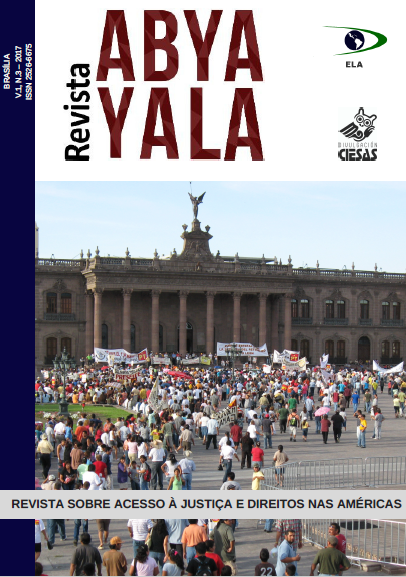Factores que contribuyen a la participación de adolescentes en delitos violentos en México
DOI:
https://doi.org/10.26512/abyayala.v1i3.7115Resumo
Este texto constituye una síntesis del informe especial "Adolescentes: Vulnerabilidad y Violencia" que la autora reslizó para la CNDH, organismo que próximanente lo publicará in extenso.
Downloads
Referências
Azaola, E. (2015) Diagnóstico sobre los adolescentes que cometen delitos graves en México. Ciudad de México: UNICEF-Secretaría de Gobernación.
Barragán, A.J. (2015) “Por el recorrido de la vida y la muerte: identidad y aprendizaje social de jóvenes sicarios en Sonora”, Tesis de Maestría en Ciencias Sociales, El Colegio de Sonora.
Bonnie, R., Johnson, R., Chemers, B. and Schuck, J. (2013) Reforming Juvenile Justice: A Developmental Approach. Washington DC: National Academies Press. http://nap.edu/catalog/14685/reforming-juvenile-justice-a-develpmental-aproach. Behavioral Sciences and the Law 18:741-760.
Cauffman, E., and Steimberg, L. (2000) (Im)maturity of judgment in adolescence: Why adolescents may be less culpable than adults. Behavioral Sciences and the Law 18:741-760.
Department of Justice (2012) Report of the Attorney General”Ÿs National Task Force on Children Exposed to Violence. Washington DC: Department of Justice.
Farrington, D.P. (1986) Age and Crime. Crime and Justice: A Review of Research 7:189-250.
Ley Nacional del Sistema Integral de Justicia para Adolescentes, Publicada en la Gaceta Parlamentaria de la Cámara de Diputados No. 4519-XX el 29 de abril de 2016.
MacArthur Foundation (2015) Juvenile Justice Report 2015. Chicago, IL: MacArthur Foundation.
Monahan, K.C., et al (2009) Trajectories of antisocial behavior and psychosocial maturity from adolescence to young adulthood. Developmental Psychology 45(6):1654-1668.
Mulvey, Edward (2011) Highlights from pathways to Desistance: A Longitudinal Study of Serious Adolescent Offenders. Washington DC: Department of Justice, Office of Juvenile Justice and Delinquency Prevention, March. https://www.ncjrs.gov/pdffiles_I/ojjdp/230971.pdf
Perea, C.M. (2007) Con el diablo adentro. Pandillas, tiempo paralelo y poder. Ciudad de México: Siglo XXI Editores.
Roberson, Clifford (2010) Juvenile Justice. Theory and Practice. Boca Raton, FL: CRC Press.
Rodríguez, Ernesto (2013) “Jóvenes, violencias y cultura de paz en América Central: enfoques, dilemas y respuestas a desplegar en el futuro”. Foro de Ministros de Desarrollo Social de América Latina y el Caribe, UNESCO.
Save the Children (2016) Las y los adolescentes que México ha olvidado. https://www.savethechildren.mx/sites/savethechildren.mx/files/resources/Las%20y%20los%20% 20adolescentes%20que%20Mexico%20ha%20olvidado_0.pdf
Steinberg, L., Blatt-Eisengart, I., & Cauffman, E. (2006) Patterns of Competence and Adjustment among Adolescents from Authoritative, Authoritarian, Indulgent, and Neglectful Homes: A Replication in a Sample of Serious Adolescent Offenders. Journal of Research on Adolescence, 16(1), 47-58.
Steinberg, L., Chung, H. L., & Little, M. (2004) Re-entry of Young Offenders from the Justice System: A Developmental Perspective. Youth Violence and Juvenile Justice, 1 (1), 21-38.
Steinberg, L. & Monahan, K.C. (2007) Age Differences in Resistance to Peer Influence, Developmental Psychology, 43(6), 1531-1543.
Steimberg et al. (2015) Psychosocial Maturity and Desistance from Crime in a Sample of Serious Juvenile Offenders. Juvenile Justice Bulletin, March, Office of Juvenile Justice and Delinquency Prevention, U.S. Department of Justice.
Downloads
Publicado
Como Citar
Edição
Seção
Licença
Copyright (c) 2017 Abya-yala: Revista sobre Acesso à Justiça e Direitos nas Américas

Este trabalho está licenciado sob uma licença Creative Commons Attribution-NonCommercial 4.0 International License.
O envio de contribuições para Abya Yala implica a cessão de direitos autorais e de publicação à Revista, observando a Atribuição-NãoComercial 4.0 Internacional (CC BY-NC 4.0) adotada.
O conteúdo dos textos submetidos à revista e por ela publicados serão de inteira responsabilidade de seus respectivos autores.
Copyright: https://creativecommons.org/licenses/by-nc/4.0/deed.pt_BR


 Este trabalho está licenciado como Atribuição Não Comercial 4.0 Internacional (CC BY-NC 4.0)
Este trabalho está licenciado como Atribuição Não Comercial 4.0 Internacional (CC BY-NC 4.0) 








